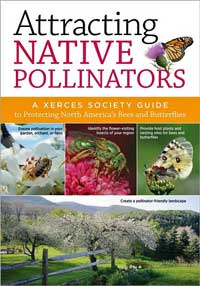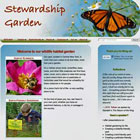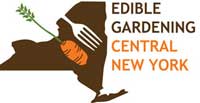|
HGCNY Shopping Guide
 | |
(Click image to download)
|
To help you find native plants in CNY, we've compiled a list of plants offered by several local nurseries. REMEMBER, nurseries can sell out of any particular plant, so it's a good idea to call before setting out on your shopping trip! DOWNLOAD: This guide is available online as a free .pdf download. |
| Bringing Back the Pollinators |
 | | Black is a co-author of this excellent book |
|
What we can all do to protect these essential creaturesElizabeth E. Rowley LectureDate: Oct. 10 at 7:30 pm Location: Cornell's Statler Hall Auditorium Speaker: Scott Black, Executive Director, The Xerces Society for Inverteberate Conservation; Chair of the International Union for Conservation of Nature Butterfly Specialist Group Black will discuss the importance of insect pollinators, outline the groups of insects that provide pollination services in North America, and present straightforward actions that each and every one of us can take to protect and provide habitat for pollinators. For more information ...
|
Project BudBurst
|
 | | When will the leaves turn color this year? |
|
This year's unseasonable, unreasonable weather is a good reminder for us to get out there in our landscapes and collect data on the life stages of plants: when they first leaf out all the way through to when the last leaves fall (and they may fall early this year). Help scientists get the information they need. Join Project BudBurst and become a citizen scientist! |
| Skaneateles Lake Watershed Events |  |
iMapInvasive Workshop Oct. 18, 7:00 pm - 8:30 pm Baldwinsville Public Library 33 E. Genesee St. Baldwinsville
Septic and Well Water Workshop Sept. 12, 5:30 - 7:00 pm United Methodist Church 26 Jordan St., Skaneateles
Funding for these events is provided by the City of Syracuse Dept. of Water
For details and to register visit www.extendonondaga.org or contact Sherry Martin at 315.424.9485 ext. 232, sm674@cornell.edu |
| Our Habitat Garden |  |
Visit Our Habitat Garden website for information on providing habitat, earth-friendly gardening practices, plants, and various creatures here in Central New York.
|
|
Join HGCNY!
|  |
Becoming an official member of HGCNY is easy: just join Wild Ones! When you're a Wild Ones member, you're automatically an official member of HGCNY. |
| HGCNY on Facebook |
As as more of us participate on our Facebook page, this will become a useful resource for asking (and answering!) local HGCNYers' questions about habitat gardening. |
| Interested in Edible Gardening? | 
|
If you'd like to get information on Edible Gardening CNY, just email John to find out about edible gardening tours and monthly programs. Free and open to the public! |
|
Our Edible Garden: updated with GROUNDHOG info!
|  | Visit OurEdibleGarden.org to see an example of a Central New York edible garden, the perfect companion to your habitat garden.
Here's our experiences with groundhogs, and here's our solution to the groundhog problem!
|
|
Greetings!
 Show Me, Help Me Tours Show Me, Help Me ToursWe had a great tour season and saw some inspiring landscapes and landscapers. Thank you to our hosts Beth and Dave Mitchell, Bill Wallauer, Chris Herrmann, and Linda Rossiter for inviting us to your properties!
SATURDAY Sept 8 is our plant sale
We will have plants donated by HGCNYers (NATIVES only, please!) as well as some on consignment from local nurseries. We'll have informal tours during the sale. (See the article below for details.)
 | Wikipedia CC
|
Our first program this year is something to hoot about!
Our first meeting this year is Sunday Sept. 30 at 2:00 pm at Liverpool Library.
Jean & Lenny Soprano of Kindred Kingdoms Wildlife Rehabilitation Inc. will introduce us to a live hawk and live owl at the library and will discuss their similarities and differences. Learn about wildlife rehabilitation and meet these birds of prey.
Mark your calendars for the last Sunday of the month for a year of terrific programs! They're free and open to the public.
~ Janet Allen
|
|
 | Crimsoneyed rosemallow (Hibiscus moscheutos),
a native hibiscus |
Our annual plant sale Sept. 8-9
We'll hold our annual plant sale on Saturday, September 8th, 10 am to noon at 401 Parsons Drive
in Westvale (directions). Plants not sold on Saturday will be available Sunday, September 9 from 1 pm to 3 pm.
People donating plants (native plants only, please!!) or helping with the sale should be here at 9 am and will be able to choose plants from 9 to 10.
If you want to donate plants but can't bring them on Sept. 8, let John know, and you can bring them earlier.
In addition to plants donated by members, we'll will have plants from some of our plant guide vendors.
PRE-ORDER trees and shrubs!!
White Oak Nursery will deliver trees and shrubs to be picked up at the sale, but you have to order them ahead of time.
Here is the procedure:
Go to White Oak Nursery and click on Potted Seedlings to see what is available.
Prices:
$10 for plants listed for $6
$11 for plants listed for $7.
The additional charge covers the cost of the pots and delivery and leaves some for funding HGCNY activities.
Larger plants (add $6 to the price listed) can also be ordered from the Trees and Shrubs section of the website but Jim Engel, owner of White Oak Nursery, suggests that you email him or phone 315.789.3509 to be sure they're available.
Once you have selected what you want to order, email or call (315.487.5742) John.
We will need your order immediately! If you can't pick them up on Sept. 8 or Sept. 9, we can make other arrangements. |
|
Why trees matter

Jim Robbins, author of The Man Who Planted Trees, says:
* Trees turn sunlight into food for insects, wildlife and people, and use it to create shade, beauty and wood for fuel, furniture and homes.
* When tree leaves decompose, they leach acids into the ocean that help fertilize plankton, which supports the rest of the food chain. * Trees are nature's water filters, capable of cleaning up the most toxic wastes. * Tree leaves filter air pollution. * A walk in the woods (known as "forest bathing" in Japan) reduces the level of stress chemicals in the body and increases natural killer cells in the immune system. * Trees release beneficial chemicals, some of which regulate the climate; others are anti-bacterial, anti-fungal and anti-viral. * Trees are the planet's heat shield, cooling cities and suburbs 10 degrees or more and protecting us UV rays. * Trees, of course, sequester carbon dioxide, a greenhouse gas. As Robbins says, "We take them for granted, but they are a near miracle." When is the best time to plant a tree? Twenty years ago. When is the next best time? Today! Read more from the NY Times article ... |
Grassland birds need grassland
 | Bobolink
|
From Mass Audubon:
"...Breeding Bird Surveys have shown alarming declines in the number of grassland birds nationwide. For instance, bobolinks have declined by 38% and grasshopper sparrows by 69% in the past 25 years.
Within New England and New York, at least 9 species of grassland birds are now recognized as regionally threatened or endangered in at least five states. Conservation of grassland habitats and changes in management practices can maintain good quality habitat for these rare birds.
Because farmland has become fragmented, most remaining grasslands have become smaller and isolated and are no longer suitable for many species requiring large tracts of grassland. Bobolinks, eastern meadowlarks, and savannah sparrows are reliant on the remaining hayfields and pastures for their survival." Grassland in Jefferson County The May-June 2012 issue Audubon magazine highlights Gail Miller's family farm in the Chaumont area that is working to protect grassland birds such as the bobolink. Audubon drafted a management plan that allows mowing only after August 15, when the chicks have safely fledged and migratory birds have moved on. Fields would be mowed in rotation, with a third of the enrolled acres cut each year, and hedgerows would be kept at bay. Read the whole story... Montezuma Grasslands The Friends of the Montezuma Wetlands Complex has one of the largest managed grasslands in New York State. Do you have some acres? * Here's information from Audubon about how to manage small grasslands for grassland birds. * NYS's DEC has a landowner incentive program. Learn more at Protecting Grassland Birds on Private Lands. |
|
Interesting videos
 | | Natural landscaping at Garden in the Woods |
Planting natives in containers
Dave Epstein of Growing Wisdom talks to Scott LaFleur, Botanic Garden Director for the New England Wild Flower Society, about the many benefits of planting native plants in containers. See the video
Three part series on natural landscaping
Part 1: Pride; Part 2: Science; Part 3: Law
This series was produced by a Wild Ones member for citizens and officials creating or updating lawn and weed ordinances for public health and safety and environmental protection.
|
|
Share a photo of your Monarch Waystation
 | | Monarch Waystation sign |
If you have milkweeds, nectar plants, and refrain from using pesticides, you're helping monarch butterflies survive, and you may even have an official Monarch Waystation.
If you've met the Monarch Watch requirements for providing for the monarch's needs, you can become certified and are eligible to purchase a sign. (Note: Monarch Watch includes non-natives on their plant list, but we suggest natives instead!)
If you have a certified Waystation, send a digital photo, and we'll create a page on our HGCNY website showing the Monarch Waystations in CNY.
Please include your Waystation number and how you would like to be identified (e.g. "Syracuse," "Sam from Syracuse," "Sam Smith at 100 Main St., Syracuse," etc.--whatever level of specificity you're comfortable with).
You're also welcome to include a brief paragraph indicating what kind of milkweed and other native nectar plants are in your Waystation and any other information of interest.
Our first Waystation The Women's Garden Club of Baldwinsville submitted our first Monarch Waystation, Yevich Trail! |
|
|
|
|